Taiwan's Housing Crisis
One of the world's least affordable housing markets, and how to fix it.
The price of housing in Taipei has tripled in the last twenty years. Three-bedroom apartments out in New Taipei City routinely sell for 20x the median annual income, making housing significantly less affordable here than even San Francisco, Sydney, Vancouver, and London1. The result is a generation priced out of housing and a dramatic collapse in family creation.
Learning this was a great shock to me. Taipei seems to be covered in highrises, and with pragmatic and low-cost construction, I assumed houses would be small but reasonably affordable, as in Japan. Instead, dysfunctional urban planning has created one of the world's least affordable cities.
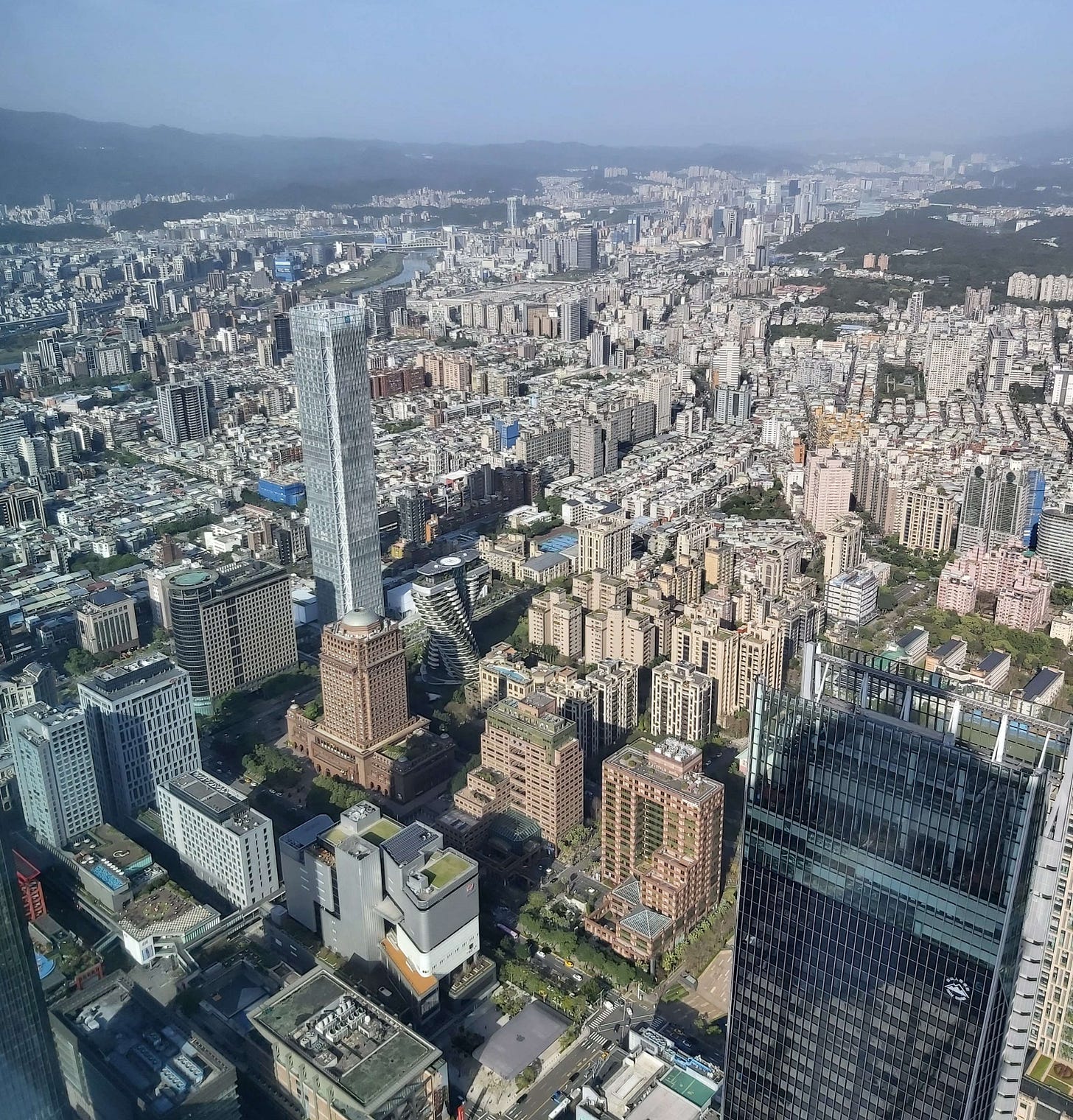
The crisis has deep roots in Taiwanese history and the transition to democracy.
In 1945, the Japanese colony of Taiwan was ceded to the Chinese Nationalists (Kuomingtang, or KMT), who began a series of disastrous experiments in collectivization. All senior judiciary, managerial, and administrative postings were replaced by KMT loyalists. Businesses and property were seized and amalgamated into state-sanctioned monopolies who, it was believed, would be more efficient under the guidance of benevolent state than in the hands of private individuals.
As with every other occasion this has been attempted, the result was a collapse in the production of goods and agricultural products and a breakdown in public services and order. Inflation skyrocketed, shortages grew, and the price of rice rose over 100x. Protests broke out throughout the country. Martial law was declared, and the protests were violently put down, resulting in the deaths of some 20,000 Taiwanese.
Severe inflation and economic stagnation continued until after the communist defeat of the KMT on the Mainland prompted the retreat of the nationalist armies to Taiwan, and a period of deep soul-searching2. A new economic model began to emerge favouring a capable state providing stability, education, infrastructure, and R&D investment, all aimed at the flourishing of private enterprise.
Land reform was a core part of this programme. Public farmland was sold, land rents were capped, and the ‘Land to the Tiller’ scheme provided state compensation to landowners in return for redistribution of land to their tenant farmers, establishing the pattern of tiny family farms that dominate Taiwan’s countryside.
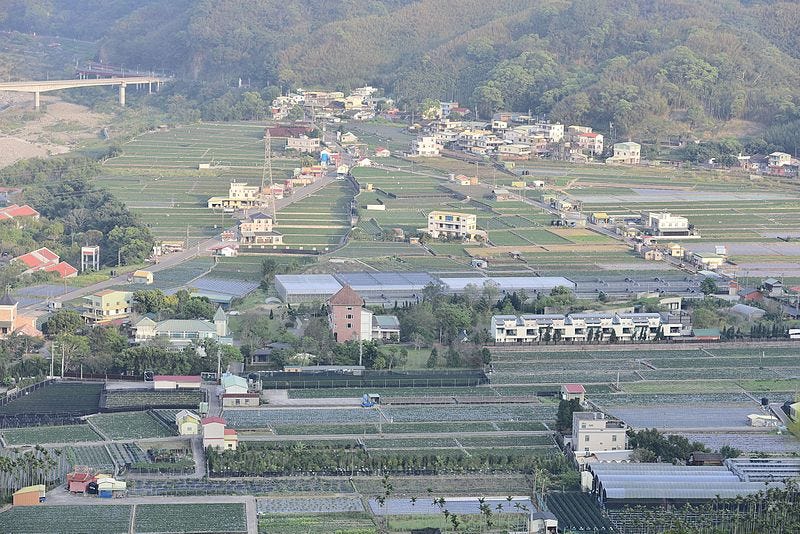
Widespread land ownership gave many a stake in society and agricultural production grew rapidly3, but it also created difficulties for urban development. Now, many owners would need to cooperate to bring enough land to market for redevelopment into a new apartment complex or factory. Meanwhile, negotiating with a single large landowner about land for public infrastructure will always be more straightforward than dealing with hundreds. The KMT government responded by exercising broad unilateral powers. Land was compulsorily acquired, rezoned, and redeveloped with the threat of imprisonment to any local opposition.
While public engagement with the state was discouraged throughout most of the KMT era, local communities remained highly connected through family and business ties. Consequently, as democratic reform began to gather momentum in the 1980s, resentment over the state’s treatment of local issues was a major driver for reform. The result was a general limiting of the power of the state, and a dramatic shift in Taiwanese land planning in particular. Now, 80% of local residents (including those surrounding the area) need to approve before redevelopment can occur.
Taiwan is a small, extremely mountainous island with a shortage of buildable land. This is particularly true of Taipei, which sits in a mountain basin. Yet many 'greenfield' areas at the edges are still theoretically available for housing. In practice, modern redevelopment is proving virtually impossible. One case I looked at, a ~1sqkm rural zoned site on the edge of Taipei, has been in rezoning negotiations for 15 years, lacking the required supermajority agreement to proceed. The surrounding area is heavily urbanised, with frequent bus links, a nearby university, and even a metro line on the way, but until a supermajority can come to full agreement on a plan (including on such details as where roads and public facilities will be situated), no redevelopment can occur.
While redevelopment laws changed after democratisation, the legacy zoning did not. The effects on housing were not felt immediately as development capacity remained4. In fact, spurred by strong economic growth and rising incomes (household income quadrupled in ten years from 1986), the 1990s were a boom time for Taiwanese housing construction. The number of completed residential units reached as high as 300,000 units/year in the mid-90s. It was not to last. Given the difficulties of further rezoning, capacity for housing development shrank rapidly. By 2000, annual completions had crashed to less than 100,000. Supply failed to keep up with demand and prices began their rapid rise. Today, despite every incentive to build and sell at record-high prices, little construction takes place. Taipei has only built 25,000 units in the last five years.
Taipei's zoning is deceptive. The city lacks a typical centre, and tall apartment buildings are permitted alongside most arterial roads, creating the impression they’re allowed everywhere. In fact, most of the city is limited to a maximum of 5-6 stories, limiting population density to around 20,000people/sqkm5, similar to Central Paris, and creating the characteristic urban form of the city:
Taipei’s zoning is much more restrictive than it first appears. Most of the buildings you see above cannot be rebuilt today due to maximum building area and floor area ratios (BAR and FAR respectively). The BAR limits the size of new buildings to 50-60% of the development site, while the FAR restricts the total private floor area of the building to 225-250% of the area of the site. This means, for example, a 1000sqm site is allowed to have a building size of up to 500sqm, with a maximum of 2500sqm of private apartments. This means the default permitted redevelopment is a five-story building on half the site6, ultimately providing a maximum of half the dwelling capacity of the existing buildings.
Each of the mini-blocks above is comprised of about 15 buildings of 5 stories each, each dwelling on a separate title. Let’s imagine a developer manages to buy all 75 of these at market prices (i.e. without any existing owners catching wind of a potential redevelopment and demanding a higher price). These dwellings lack modern amenities like large windows, elevators, and passive cooling, and they sell for about $13-15m NTD each7. However, for reasons that will soon become evident, many of these dwellings are poorly maintained and have lower sales prices. Optimistically, $12m on average, for a total market value of the block of $900m NTD.
A new apartment will sell for a substantial premium, at around $20m NTD. However, with B/FAR, a new building will only provide around half the yield, at around 38 dwellings. This means the total market value of the new building is only $760m! Despite replacing a poorly maintained building with a brand new one, and entirely absorbing construction and transaction costs (legal fees, agent fees, sales taxes, sweeteners for holdout owners, etc.), our hypothetical developer has only managed to provide fewer homes and destroy $140m of value.
It’s no wonder then, despite continued low construction costs and the staggering growth of the Taiwanese economy, the majority of the cheaply constructed housing of the 1960s and 1970s remains today. They’re uneconomic to replace, and as they continue to age, increasingly uneconomic to even maintain.

The strategic thinking behind the use of B/FAR is to manage the effects of density on public infrastructure. Despite the success of the Metro, Taipei has fallen behind on providing many public services. Water supply is consistent, but not considered drinkable due to poor piping. Wastewater blockages are common. Footpaths are of poor quality. Local parks, swimming pools, and community centres are often dated, suffering from severe maintenance problems, and stretched beyond capacity.
Allowing more people to live in a district only increases the pressure on these services. The government policy response tries to incentivise developers to provide public amenity in return for additional FAR allowances. Circumstances vary across different jurisdictions, but as examples:
+50% FAR for providing additional carparking for public lease
+30% for providing a public plaza area on-site
+15% for a footpath or qi-lou (an inset footpath that sits below the first-floor)
+10% for tree planting along the site boundary
+10% for providing an onsite gym/swimming pool/lounge/library, etc.
FAR incentives are capped by law to no more than an additional 150%8. However, developers can also buy and transfer unused FAR rights from other properties in the city (making a mockery of the idea that the policy helps to control density within a local area). Add enough FAR bonuses and rights together, and you eventually arrive at a viable project providing enough gross profit to cover transaction costs, construction costs, interest costs, taxes, and return a healthy enough profit to incentivise redevelopment:
The situation is completely insane. In return for some of the world’s least affordable housing, the city receives scraps of mostly theoretical public amenity. Unnecessary second footpaths, essentially inaccessible public plazas, and tiny libraries and swimming pools that go unused even by building residents. These push up construction and maintenance costs for minimal public benefit.
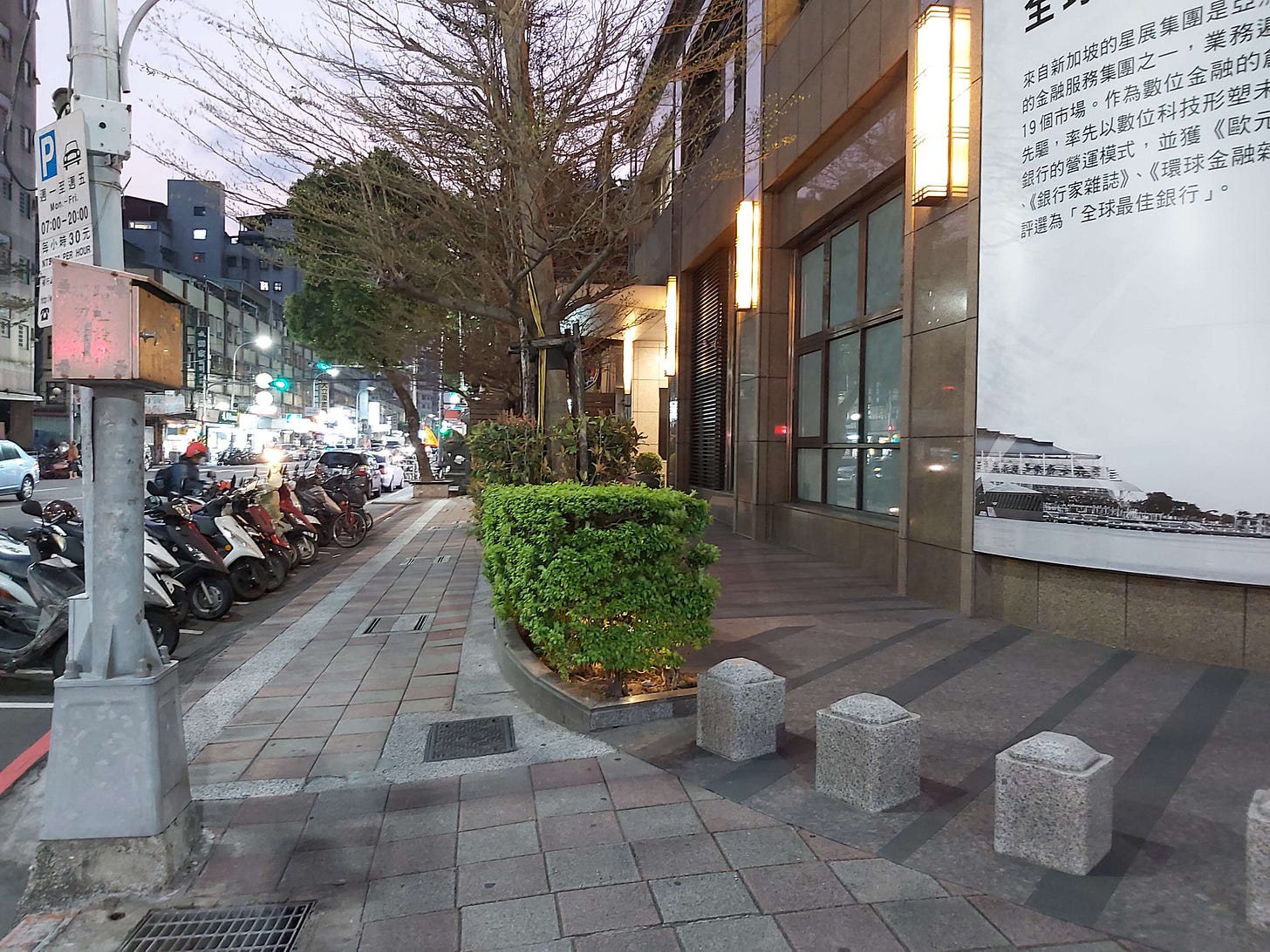
Taiwan is a young democracy. Most political attention is absorbed by the issues of cross-strait relations, Taiwanese identity, and the question of formal independence. The recent presidential election was widely regarded as a referendum on these issues. Given this focus, it seems to me that Taiwan has yet to develop a vibrant ‘middle-layer’ of public discourse on issues like housing, defence, and education. People talk about these topics with their friends, but a robust and well-informed public discussion supported by think-tanks, universities, and other such institutions is still sorely lacking.
Whatever the reason, Taiwan has yet to address the fundamental issue of a supply shortfall. Instead, the analysis of local media and politicians remains superficial, and focuses instead on managing essentially inelastic housing demand. Well-intentioned government policy here has often making the problem worse and compromising other strategic goals.
Counterproductive Taxes
The government levies a range of property taxes. These taxes incentivize certain types of behaviour while disincentivising others. For example, Taiwan levies taxes on ‘amusement places’ like nightclubs, theatres, music venues, magic shows, and dance halls. The tax explains Taipei’s relative lack of these facilities, and also the abundance of bars, cafes, restaurants, and other gathering places that escape having to pay the tax.
The key taxes affecting the supply of residential property in Taiwan are land taxes, housing taxes, and taxes on the sale of housing.
When tax is charged on the value of the land (rather than what sits above it) it encourages landowners to make valuable investments in that site. An alternative approach is to tax the total ‘capital value’ of the property. This encourages the opposite - land banking of vacant lots, and smaller investments than otherwise to minimise the tax burden.
Taiwan’s approach is a mix of the two: a broad-based land value tax that generally encourages efficient use of land, but combined with a housing value tax that discourages housing in particular and allows for a lower land value tax rate. Further, an exemption is made in the land tax law for parking lots, agricultural warehouses, and cram schools9. In a country crying out for more housing, the net result of these laws is that housing is discouraged while vast swathes of premium real estate are wasted on surface parking lots and low-value commercial buildings.
It gets worse! An appropriately titled ‘special privileged tax rate’ for housing taxes is offered for owner-occupied properties. This deduction ranges from 66% to an 80% discount in New Taipei City. In terms of their contribution to the upkeep of the city, this effectively means those lucky enough to own their own home are subsidised by everybody else.
Taiwan also places a range of taxes on the creation of property. New property deeds are taxed at 4% of the value of the property. Partition of an existing property is charged 2% of the combined value. These taxes discourage capital investment in property (relative to other forms of investment like overseas capital markets) and discourage partition of property to enable more people to live in a given area of land.
In another misguided attempt to limit rising sales prices, housing sales are taxed at 6%. With supply/demand unaddressed, this only serves to reduce housing mobility. Instead of downsizing to a smaller apartment once the kids leave home, freeing up the home for a young family, these taxes encourage people to stay on, only to eventually hand the property down to their children once they’re too old to raise a family of their own.
Finally, the government levies a ‘Land Value Increment Tax’, essentially a capital gains tax on property, further discouraging people to sell, reduced investment in property relative to other investment vehicles untaxed in this way (e.g. discouraging badly needed refurbishment of older properties). However, it does allow the city government to capture some of the heightened property values caused by their regulatory regime.
The net effect of these taxes is to create a split society. Those who own property enjoy a range of special tax privileges (especially if they never sell), while the younger and less well-off are squeezed as more of society’s paper wealth becomes locked up in housing.
Other policy failures
Promises to provide more social housing have been a long-running major policy platform of both national and city government politicians. Unfortunately, results have been limited because, unlike Singapore, the state has no mechanism to bypass its own planning laws, so state-led development faces all the same barriers and difficulties as private sector development, in fact competing for available sites, bids up the price of transfer rights, etc. No winning here without zoning reform.
Acknowledging the issue with maintenance, the government recently passed the ‘Statute for Expediting Reconstruction of Urban Unsafe and Old Buildings’ where buildings ‘not reaching minimum structural safety standards’ receive a bonus 10% FAR to incentivise reconstruction, declining to 1% by 2028.
Returning to our earlier example, here’s how the enhanced FAR works in practice:
If this is the policy response for even cases of structurally unsafe buildings, the country is still fundamentally unserious about the scale of the problem.
Here are my proposals for fixing this mess:
1) Large-scale upzoning and elimination of building/floor area ratios
Demand-side thinking and policy has created a disaster for young Taiwanese, and consequently, for the nation. If young people cannot afford housing, they’re far less likely to start businesses and families. Taiwan is aging rapidly. The generation born today is already 1/3 the size of those 40-50. Fertility is among the world’s lowest. A nation without children has no future.
Upzoning works. After Auckland’s widespread upzoning in 2016, the number of building completions rose over 50% to record levels. Affordability is improving rapidly. Rents, previously unrelenting, have since stagnated - falling relative to incomes and inflation.
House prices are high because people want them and are willing to pay for them. A programme of zoning deregulation would unlock this latent value. It would spur a construction boom (placing upward pressure on stagnant wages), allowing the city’s crumbling buildings to be replaced with modern apartments of higher quality, and in much greater quantity, finally allowing supply to catch up to demand.
2) Eliminate the housing tax, and tax breaks for surface parking, and other inefficient uses of land.
The taxes on housing are well intentioned, but counterproductive to the goal of getting more houses built. Let the market determine the best use of land. Right now, high prices are the only signal required for people to make money by providing more housing, if the government would only allow it.
Many people are in larger houses they no longer need. Nostalgia and personal connection will keep many of them where they are, but the government should not be putting up tax barriers in the way of people downsizing and opening up those dwellings to families that need the space.
Taipei is space-constrained. A tax regime that favours surface carparking comes at the cost of something else more useful that could be on that land instead. Remove the tax breaks for carparking. If motorists want more parking, then they can pay its true cost rather than being subsidised by everyone else.
3) Address density concerns separately through ‘development contributions’
Taiwan gets very poor results from relying on B/FAR incentives to address density and provide amenity. Instead, the city government should be empowered to capture a proportion of the large increase in capital values enabled by deregulation, and use this funding to improve public services.
As you can see, such a framework would allow many more houses to be built, while providing a much needed injection of capital into local governments, allowing investment in modern facilities, footpaths, water pipes, sewers, and other required infrastructure.
4) Build a movement
As we’ve seen in New Zealand, this means a decade or more of sustained effort before generating enough momentum to translate into policy changes. It involves supporting grass-roots organisations of pro-housing young people, academic research, and think-tank policy development.
The idea is to create a movement for political change supported across each level of analysis. Politicians need to see this as a vote winner, and that requires a broad base of people who see the (normally abstract) issue of zoning reform to be in their interest. Students need to be talking about these issues at university and on social media. Activists and economists need to be on the radio/talk shows laying out the moral and economic case for reform. When politicians start to become interested in the idea, the movement needs to be prepared with detailed proposals laying out how it all works in practice, including anticipating objections and providing politically viable solutions.
Success would require building and sustaining a broad coalition for change, but the seeds could be planted by a lean organisation of a dozen or so dedicated individuals. You’d need: a charismatic media-savvy leader type; policy specialists in planning, law, and urban economics; creatives able to make a splash on social media; networking types able to reach out and convert key groups like politicians, students, and existing housing pressure groups into the movement; and several talented administrators able to smooth the way, distribute and monitor funding, bring international speakers to key events, etc.
Even with funding for scholarships and community organisation grants, this could still be delivered relatively cheaply: something like $1.2m USD/year salaries, and as much again to cover overheads and other expenses. So something like $22m USD over 10 years, far outside the budget of the young people who most need this to be done, but well within the means of a small group of patriotic Taiwanese-American business people or software developers.
One way or another, Taiwan's housing crisis will resolve itself. Currently each generation is half the size of the one before. Taiwan’s population has plateaued and is beginning to fall. In the absence of change, demand (i.e. the number of people wanting houses) will continue to fall to meet static supply, leaving another generation locked out - with dramatic implications for Taiwan's future.
Estimates of Taiwanese housing affordability vary considerably. The ‘median sale price’ method (often quoted in media articles) is an easy way to look across cities in North America or Australia, where the median dwelling is a broadly comparable house in the suburbs. However, it tends to obscure more than it reveals when applied to Taipei, where dwellings have fewer and smaller rooms and minimal additional land area.
Using ‘price per square metre’ allows a more direct comparison. Taipei apartments within walking distance of central metro stations are approx $13000USD/sqm, higher in absolute terms than Vancouver, and not far behind New York. Consider though that the median Taiwanese salary in 2023 was ~$22000USD. Levelised affordability in these terms produces figures as high as 28x annual median income.
Nationalist leader Chiang Kai-Shek, though undoubtedly flawed in many ways, deserves some credit for his willingness to put aside ideology and honestly reflect on his failures.
Increased land supply and reduction in land rents created surpluses for farmers previously working barely above subsistence. These surpluses, along with generous loans, enabled farmers to invest in their newly-owned farms in the form of modern machinery, new techniques and seed-stock, etc. Agricultural production doubled in the decade following these reforms and continued to rise throughout the remainder of the century as the green revolution took hold.
Non-residential sites have been relatively plentiful due to greater relative supply and the 'mixed-use by default' zoning that makes lower stories throughout the cities available for commercial use such as restaurants, small offices, retail outlets. In addition, the government has been delivering a series of ‘Ease of Doing Business Reforms’ since 2008, aimed at reducing barriers to entry for small businesses such as waving fees, tax-writeoffs for startups, and implementing an online ‘one-stop shop’ for everything from permits and registration to infrastructure connections. These enablers of small-business contribute greatly to the vibrancy of Taiwanese cities, and should be widely adopted abroad.
While small commercial businesses continue to thrive, large industrial companies have lately begun to struggle as industrial land capacity begins to run short. Even TSMC, Taiwan's highest prestige and most politically well-connected company has struggled to navigate the redevelopment process required to build new chip fabs in recent years, driving their expansion overseas to Japan in particular.
Population density estimates vary due to administrative boundaries, and whether nearby Taoyuan and Keelung are considered part of ‘Taipei’. While these cities do share strong economic ties, and many Taiwanese do commute from these areas, for the purposes of this discussion, I’m considering the continuous urban area of ‘Taipei City’ and ‘New Taipei City’, home to roughly 6.6 million people across some 300-400sqkm of urban area (the majority of the administrative area, like Taiwan in general, is highly mountainous).
Actually, this example would likely end up as six story building (if allowed under height limits), after lift lobbies, shafts, and other ‘shared’ spaces that don’t contribute to the FAR are added. The fact that these spaces can be provided ‘for free’ incentivises absurd outcomes in such a space-constrained city, such as how otherwise modest apartment buildings in Taipei will typically have grand lobbies covering the entire ground floor. On the whole, these ‘requirements’ simply make new housing more expensive, and reduce development capacity for minimal public benefit.
Many of the floors in these buildings will have been split into multiple smaller dwellings, making the acquisition that much more difficult. However, the price/floor area is similar, so for the sake of simplicity, let’s imagine that these are all 3-bedroom dwellings.
The FAR incentive cap is legislated in the Urban Renewal Act, article 65. The act allows for up to a 200% bonus in the case of ‘strategic renewal areas’ which can be specially designated by the local authority in areas close to a railway station or airport, which also provide land value/housing tax reduction for a period of up to two years. I’m told this happens extremely rarely in practice.
Private school tax exemption provided in Section 3, Chapter 2, ‘Land Tax Reduction and Exemption Regulations’, of the Land Tax Act. Note that cram schools also receive other tax benefits, such as generous government health insurance subsidies 350% higher than those received by any other private enterprise.
Tangentially, I’m routinely told that standards are very poor in these institutions. Long hours, Tests are typically given every two days, with the remainder of the time spent teaching to the next test, with little educational benefit. Unfortunately, Taiwanese society is highly structured around these schools, such that opting out leads to lower expectations for the child by their school teachers, segregation into lower quality schools/lower streams within those schools, and difficulty in adjusting to such an intensive environment upon reentry. It’s not that the system is entirely without benefit, but it’s a product of the hyper-competitive years during the population boom of the late 20th Century (many people competing for relatively few stable well-being jobs), and ill-suited to the reality of a working-age population now projected to halve within a generation with too few people to fill required roles.




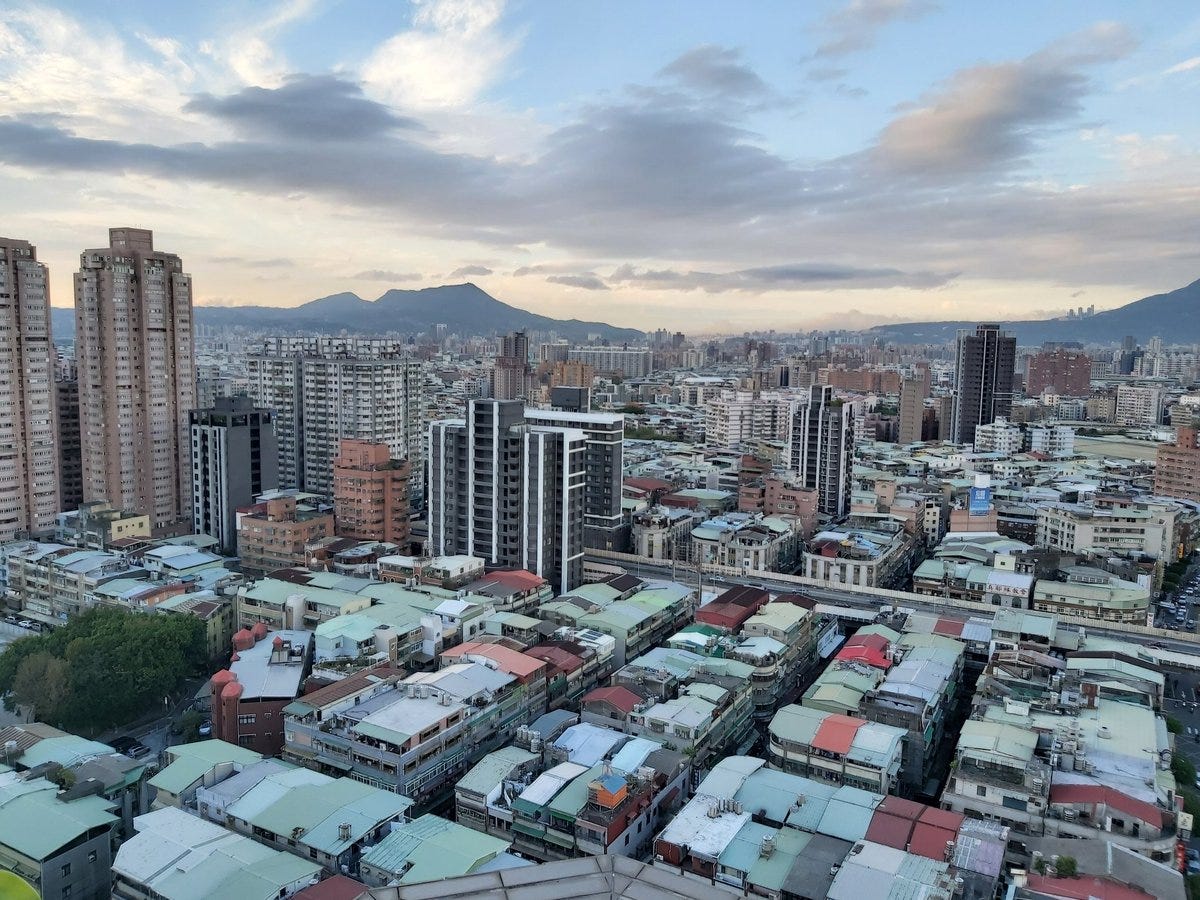



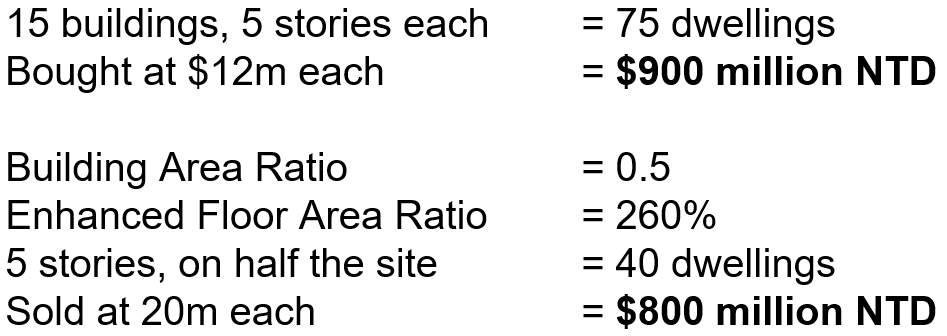

This is a fantastic piece and thank you for sharing. I did not know that Taipei was having this problem, it seems to be flying under the radar. I have an essay coming next week at Risk & Progress that echos the sentiment here:
1) Remove taxes that impose costs on building things.
2) Ease zoning regulations that artificially inhibit the ability of housing demand to meet supply.
The latter is an issue, as noted in this article, of giving too much NIMBY veto power at the local level. Too much “democracy” can be a problem, which is why zoning regulations should not be a locally controlled issue. This seems to work well in Japan.
Interesting post! I just returned from living in Kaohsiung for 6 months. I wonder if you have any idea how much what you're describing also applies in other Taiwanese cities. I know there's been a fair bit of construction in Kaohsiung over the past two decades, but I'd guess it's not keeping up with demand, as new apartments there are quite expensive.
Aside: You use the word "spurn" a couple times where you should use "spur". "Spurn" means to strongly reject, not to encourage.